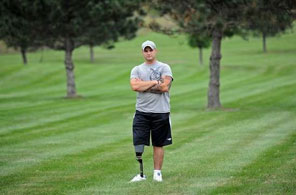By DANIEL WOOLFOLK TIMES STAFF WRITER
Story Courtesy of the Watertown Daily Times:
FORT DRUM — Spc. Matthew R. Hayes stood frozen, not sure which way to move. With one soldier already lying on the ground injured, Spc. Hayes and other 10th Mountain Division soldiers now realized that the Afghan hill they had just climbed was riddled with an unknown number of nearly undetectable plastic land mines.
So the soldiers decided that the only way to avoid another casualty was to carefully retrace their steps to safety.
But Spc. Hayes didn’t know he was already standing on a land mine.
“I shifted to step off and it exploded,” he said. “I didn’t know what was going on — just a little confusion … dazed — I couldn’t do anything.”
He fell back on his shoulders. He didn’t feel pain — just a strong pressure on his right leg.
“I looked down and I just saw my foot shredded,” he said.
He quickly reached for his tourniquet to tie his leg tight and stop the bleeding. He began feeling weak, and yelled, “Medic!”
His mind raced ahead as to what might happen.
“I figured I’d lose it,” the 22-year-old soldier said.
He was right.
Within hours of that explosion last September, Spc. Hayes’ leg was amputated below his knee, adding his name to the list of almost 900 soldiers nationally who have had a major limb amputation as a result of explosions in Afghanistan and Iraq, according to an Army Medical Command spokeswoman. More than half of the 10th Mountain Division’s 278 soldiers killed in Iraq and Afghanistan have died as the result of improvised explosive devices and anti-tank mines.
Yet within months of that explosion, Spc. Hayes was taking his first steps with help of a prosthetic leg.
“It felt great,” he said. “It was weird trying to remember how to walk, I guess, not being able to use an ankle.”
Each similar success story can be credited to the advanced prosthetics technology that the U.S. government is investing in. Last year, for instance, Clarkson University, Potsdam, received a $1.4 million grant from the Army to develop a prosthetic leg that uses sensors that respond to the remaining leg muscles.
Roger R. Howard, of Howard Orthotics and Prosthetics in Watertown, said working with highly active soldiers wanting to maintain their lifestyles is a challenge he enjoys. His civilian customers are benefiting as well.
“Any time there’s a war, the government puts a lot of money into research and development,” he said, “and as a result of that we have manufacturers coming out with newer systems at a much faster pace than ever. The computers are getting better, and the hardware is getting … lighter.”
Mr. Howard works with soldiers who test out the high-tech systems and give companies vital feedback.
“The manufacturers are listening,” he said. “If it holds up to a 25-year-old male who is running a couple of miles a week … it’s going to hold up for the rest of the population, so we’re seeing products come out quicker right now because of the war.”
Sgt. Roy A. Mitchell, attending an Adopt-A-Platoon picnic at Camp Wabasso in 2005, lost his leg when his humvee ran over a mine in 2003.
The improved prosthetics have allowed some 200 soldiers to remain on active duty, despite an amputation. Sgt. 1st Class Roy A. Mitchell, a 40-year-old former infantryman who lost his left leg above his knee in a 2003 mine blast in Afghanistan, is now an Army career counselor at Fort Drum’s 3rd Battalion, 85th Infantry Regiment, Warrior in Transition Unit. Using a prosthetic leg, the 40-year-old sprints, coaches football and still practices his tae kwon do kicks.
A chip within his prototype leg calculates data that keeps Sgt. Mitchell upright, even for seemingly insignificant tasks such as going up stairs or locking a knee,
“There are a lot of features that the computer does that I don’t even have to think about,” he said of the Otto Boch X3 generation 3 leg he is testing for the company. “You’re seeing systems like this one that eight years ago wasn’t a thought in anybody’s mind.”
A lot of technology was never put into practical use because it never had people to test it on, Sgt. Mitchell said.
“The prosthetic world … hasn’t had that active population to take in and field test these high-speed prosthetics,” he said. “Now they have this young population that is highly active.”
Yet amputations from war often differ from an amputation in the civilian world that is the result of diabetes or another disease.
Many soldiers who lost limbs in blasts don’t have the luxury of a methodical surgical removal, so the cuts are messy and often don’t allow enough skin to heal around the limb, Mr. Howard said. The patients then require skin grafts that leave the soldier with new tissue that isn’t as elastic or resilient as the natural skin.
“When you throw that on a 25-year-old male that is motivated and intelligent and ready to continue to live the active lifestyle that he lived, you have a lot of
things stacked against you to keep that skin from breaking down,” he said. “So you’ve got to have a super-great fit to prevent those skin grafts from coming apart.”
WANTING THE BEST
In 2007, Fort Drum activated the Wounded Warriors unit, where injured soldiers heal and transition to a unit and civilian life. The unit also is where amputees on
post get to know one another, which means they scrutinize each other’s prosthetics.
They ask Mr. Howard why they don’t have what their buddies do and he must always be able to justify why the soldier is fitted with any particular piece of
equipment.
“When you’re doing what you do and you love what you do, it’s fun to have questions asked of you, and these guys do it,” he said.
Soldiers who have recently had an amputation go through a “you’re not going to tell me I can’t do it” phase, Sgt. Mitchell said, but he has learned from older
amputees that too much stress on the good limb can lead to knee and hip replacement.
The sergeant’s bulky, muscular right leg shows just how much work it does.
“There’s going to be that given added pressure on the good side,” he said. “Don’t overdo it, because then you’re going to start tearing up what you already have.”
In the past year, since he was injured, Spc. Hayes has decided to leave the Army and move to Arizona, where he will study auto mechanics. He has made a few changes to his fitness regimen. He’s more careful how he lifts weights and is slowly getting back to running two miles. He can do a half-mile in a half-hour, but is getting used to the additional pressure the running puts on his legs.
He has, however, started golfing again and completed a 90-mile bike ride in Florida.
But even with those accomplishments, he may have met his match — his energetic 2-year-old daughter, Lilie A., who gauges exactly what she can get away with.
“She knows she can outrun me, too, if I don’t have the leg on,” he said. “She’s just all over.”

